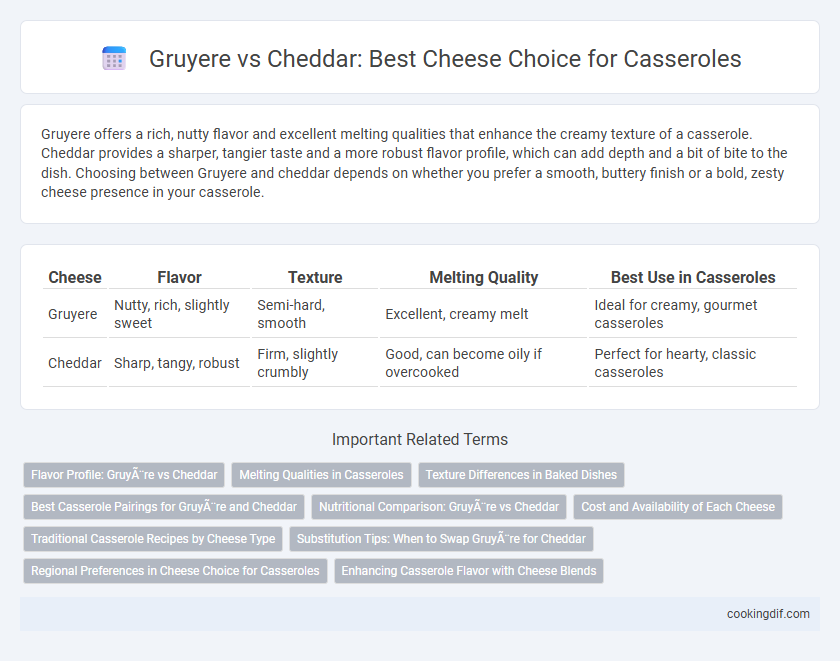Gruyere offers a rich, nutty flavor and excellent melting qualities that enhance the creamy texture of a casserole. Cheddar provides a sharper, tangier taste and a more robust flavor profile, which can add depth and a bit of bite to the dish. Choosing between Gruyere and cheddar depends on whether you prefer a smooth, buttery finish or a bold, zesty cheese presence in your casserole.
Table of Comparison
| Cheese | Flavor | Texture | Melting Quality | Best Use in Casseroles |
|---|---|---|---|---|
| Gruyere | Nutty, rich, slightly sweet | Semi-hard, smooth | Excellent, creamy melt | Ideal for creamy, gourmet casseroles |
| Cheddar | Sharp, tangy, robust | Firm, slightly crumbly | Good, can become oily if overcooked | Perfect for hearty, classic casseroles |
Flavor Profile: Gruyère vs Cheddar
Gruyere offers a nutty, slightly sweet flavor with a smooth, creamy texture that melts beautifully, enhancing casseroles with a rich, sophisticated taste. Cheddar provides a sharper, more pungent flavor, ranging from mild to extra sharp, delivering a bold and tangy kick that stands out in hearty dishes. The choice between Gruyere and cheddar depends on whether a mellow, complex flavor or a vibrant, intense cheese profile is desired for the casserole.
Melting Qualities in Casseroles
Gruyere offers excellent melting qualities for casseroles, creating a smooth, creamy texture with a nutty, slightly sweet flavor that complements savory dishes. Cheddar melts well but can separate if overheated, sometimes resulting in a grainy or oily texture, especially in sharper varieties. For optimal casseroles, Gruyere's superior meltability and flavor stability make it a preferred choice over cheddar.
Texture Differences in Baked Dishes
Gruyere cheese melts smoothly with a creamy, silky texture that enhances the richness of casseroles, offering a nutty flavor and a slightly stretchy consistency when baked. Cheddar provides a firmer, more crumbly melt that can create a denser, sharper-tasting dish with a slightly granular texture in baked casseroles. Choosing Gruyere results in a velvety smooth interior, while cheddar delivers a bolder taste with a more defined cheese structure in the final baked dish.
Best Casserole Pairings for Gruyère and Cheddar
Gruyere cheese offers a nutty, slightly sweet flavor that melts smoothly, making it ideal for creamy, savory casseroles like chicken and mushroom or potato gratins. Cheddar provides a sharper, tangier taste with a firm texture that complements hearty casseroles such as broccoli and bacon or chili bake. For best casserole results, pair Gruyere with delicate ingredients and mild seasonings, while Cheddar works well with bold flavors and robust meats.
Nutritional Comparison: Gruyère vs Cheddar
Gruyere contains approximately 413 calories and 33 grams of fat per 100 grams, offering higher calcium at around 1011 mg compared to cheddar's 721 mg. Cheddar provides more protein, about 25 grams per 100 grams, and slightly lower fat content near 33 grams, making it a richer source of vitamin A with 265 IU versus Gruyere's 344 IU. Both cheeses deliver essential nutrients but differ significantly in calcium and vitamin profiles, impacting their suitability for health-conscious casserole recipes.
Cost and Availability of Each Cheese
Gruyere typically costs more than cheddar due to its artisanal production and Swiss origin, making it less accessible for budget-conscious casseroles. Cheddar is widely available in supermarkets worldwide, with various price points that suit most grocery budgets. The cost-effectiveness and ease of finding cheddar often make it the preferred cheese for everyday casserole recipes.
Traditional Casserole Recipes by Cheese Type
Gruyere, prized for its nutty and slightly sweet flavor, melts smoothly, making it ideal for traditional French and Swiss-style casseroles that require a rich, creamy texture. Cheddar offers a sharper and more robust taste, enhancing classic American casserole recipes such as macaroni and cheese or broccoli cheddar bake with its bold flavor profile. Both cheeses provide excellent melting properties but differ in flavor intensity and regional authenticity, influencing the overall taste and character of traditional casserole dishes.
Substitution Tips: When to Swap Gruyère for Cheddar
Gruyere delivers a nutty, slightly sweet flavor and melts smoothly, making it ideal for classic French-style casseroles. Cheddar offers a sharper, more robust taste and firmer texture, suitable when a bolder cheese presence is desired or Gruyere is unavailable. Substitute Cheddar for Gruyere in recipes expecting less creaminess but more tang, adjusting cooking times to prevent Cheddar from becoming oily or grainy.
Regional Preferences in Cheese Choice for Casseroles
Gruyere cheese is preferred in European-inspired casseroles, especially in Swiss and French regions, due to its nutty, creamy texture that melts smoothly without becoming oily. Cheddar dominates casserole recipes in North America, prized for its sharp flavor and firm melting properties that add richness and depth. Regional culinary traditions heavily influence these cheese choices, with Gruyere enhancing delicate and nuanced dishes, while cheddar supports robust, hearty casseroles.
Enhancing Casserole Flavor with Cheese Blends
Combining Gruyere and cheddar cheese enhances casserole flavor by balancing Gruyere's nutty, creamy richness with cheddar's sharp, tangy bite. Gruyere melts smoothly, creating a luscious texture, while cheddar adds depth and a robust savory note that complements vegetables, meats, and sauces. Using both cheeses in a blend optimizes taste complexity and gooey consistency, elevating the overall casserole experience.
Gruyère vs cheddar for cheese choice Infographic

 cookingdif.com
cookingdif.com